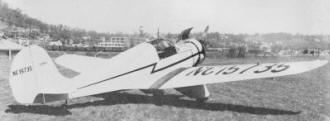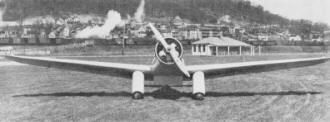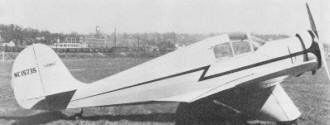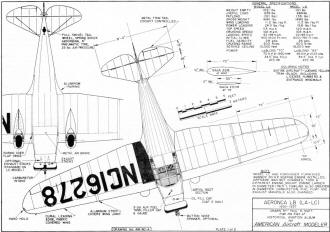|
Low-wing airplanes had not quite
caught on with the flying public prior to World War II, so Aeronca had an uphill
battle in gaining acceptance of its "Model-L" series of planes. It ended up being
a complete success. The article has an interesting tale of salvaging partially-complete
airplanes during a flood in Cincinnati in 1937 using techniques that would never
be allowed in today's highly regulated and monitored world. Interestingly website
visitor Glen M. sent me a photo of an Aeronca LC on floats - the "LCS" model
the author of this American Aircraft Modeler article suggests might have
never been built. To be fair, finding obscure information was a lot more difficult
in 1969, long before the Internet put petabytes of data at everyone's fingertips.
Aeronca Model L Series Article & 4-View
One of the first truly successful cabin low-wingers to enter the private market,
the "L" was another ahead-of-their-time unfortunates.
Paul R. Matt
To many aeronautical buffs the introduction of the Aeronca low-wing in 1935 earmarked
this design as one of the most interesting and eye-appealing airplanes ever produced.
It was then, and would forever be, a classic example of progress in light-plane
design and engineering.

The model L series (LA-LB-LC), which followed another classic design by Aeronca,
the C-2 and C-3, was indeed a marked departure in private aircraft during this period
of time. Not only was the Model L a change of pace for the Aeronca firm but it can
well be classified as one of the first truly successful cabin low-wing aircraft
to enter the private and commercial market. At the time the number of low-wing air-craft
available to the private buyer could be counted on one hand.
The 70-hp Aeronca cruised over 100 mph, with range over 500 miles and initial
climb of 600 ft. per min. Similarly powered planes 30 years later have not bettered
this performance. Landed at about 45 mph.
Recalling some of these single-engine low-wing machines that appeared in the
1930's is not difficult. The Fairchild 45 and Spartan 7W were large, 4-5 place,
rather expensive machines. They had good all-around performance but were costly
in operating expenses and intended for the executive transport market. Curtiss-Wright
introduced the 19W Coupe, powered with a 90-hp Lambert engine. It was underpowered,
suffered aerodynamic problems and was abandoned as a commercial product.
The Kinner Envoy-Playboy, Bellanca Junior, Dart G and Culver Cadet series of
the late 1930's were of a better breed in the lightplane field. Most became quite
successful. The Ryan SC of 1938 was about to make inroads but World War II intervened.
Generally speaking, it can be said that the cantilever, low-wing aircraft was pretty
well reserved for the military and transport field prior to the war. The Aeronca
thus stands out as a pioneering design and a bold thrust into the future, for it
was a 1935 production machine.

The Aeronca low-wing was designed by Giles E. Barton. The first of two prototypes
was produced in the fall of 1935. Final general-arrangement drawings were completed
in October. The first plane, X 14558, rolled out of the Aeronautical Corp. of America's
plant in Cincinnati, powered with the standard Aeronca E-113 40-hp horizontally
opposed, two-cylinder, air-cooled engine. This was the same powerplant used on all
preceding C-2 and C-3 models. It seemed fitting and economically advantageous to
employ the same engine in the new low wing design - a decision made by the executive
department over some protests of the design engineer.
The aircraft, although of new configuration compared to what the company had
been building, was nevertheless conceived as a light-weight two-place machine. Initial
studies appear to have confirmed the fact that the E-113 would render sufficient
power. In practice the combination proved otherwise. The prototype was pitifully
underpowered. A few abortive hops were reported in which the plane staggered into
the air for a few brief seconds and then fluttered back to earth with a resounding
bounce.
The plane was immediately modified to accept a larger and more powerful engine.
The 70-hp LeBlond radial was chosen. The five-cylinder air-cooled engine had proven
its reliability, low cost upkeep, honest output, and being locally manufactured,
was readily available.

The new plane now weighed around 1,650 pounds, quite a bit more than Aeronca
was used to. The high-wing C-3 weighed in at the 1,000- to 1,010-lb. mark. The E-113
engine was adequate for these "powered gliders," as they were often called. With
the low-wing, however, certain aerodynamic features come into play which are different.
Here the C.G. becomes more critical and there isn't the pendulum weight of a fuselage
hanging below the supporting surfaces to render some inherent stability. The LeBlond
engine provided nearly double the power of the E-113 and, with this, the low-wing
model proved highly successful.
Once a balanced power-to-weight ratio was established, the plane was reworked,
streamlined and faired out into more appealing lines. By the end of the year the
second machine was brought up to "production line" standards and, after extensive
testing, manufacturing and sales promotion got under way.
Construction of the model Ls was conventional for the day, The fuselage was of
welded chrome-molybdenum steel tubing, faired with plywood bulkheads and stringers
and fabric covered, The Aeronca triangle steel-tube method of construction was employed
for the basic framework, Aluminum was used for covering between the engine and firewall.
The engine was cowled with a Townend ring-cowl and a full engine-crankcase fairing
plate was employed to assist in smooth airflow between the cylinders,
The wing was built in three sections. The center section was exceptionally long,
measuring 18 ft. Two spruce box spars were used and the ribs were of truss type
construction. Double drag-wire trussing was used throughout. The leading edge was
of dural. A 19-gal. gas tank was situated in the center-section just right of the
fuselage. A second tank of nine-gal. capacity was located just ahead of the instrument
panel in the fuselage.
The fuselage itself was clamped to the center-section, making these two components
an integral structure. The wing-tip sections had solid spruce spars, truss-rib construction
and double drag-wire trussing. The entire wing was fabric covered. The outer sections
were joined to the center section by four tapered bolts. An aluminum fairing strip
covered the joint. The wing was exceptionally rigid and torsionally stiff.
The ailerons were of built-up dural channel sections, riveted together and fabric
covered. These were attached to the rear spar by three piano hinges. A static balance
extended below and forward of the control arm on each aileron. (See the drawings.)
Tail surfaces were of welded steel tubing and fabric covered. The fin was built
integral with the fuselage framework. The stabilizers were interchangeable, rigidly
fixed to the fuselage and wire braced. The left elevator had an inset dural trim
tab which was operated from the cockpit by means of a cable control.
The landing gear had twin Aeronca-developed oleo struts. There was sufficient
room between the parallel struts to accommodate air wheels of 7.00 x 5" to 18 x
8" size. The wheels were equipped with brakes, operated through a Bowden wire to
the control in the cabin. Large full-skirted aluminum fairings formed classic wheel
pants.
The cabin was upholstered and sound-proofed with Sealpac insulation. The extra
large entrance door was located on the right side only. The small windows on each
side of the cabin could be opened for ventilation. The overhead windows were tinted
green pyrolin to act as a sunshade, but still provide exceptional upward and rearward
visibility. Seating was side-by-side with dual control sticks and rudder pedals,
Each set of controls had individual cable systems and were not a "throw-over" method
or interconnected at the cabin juncture.
The rudder pedals were adjustable and acted as brakes when a hand lever at the
right of the pilot was pulled back. This hand brake also acted as a parking brake,
being interconnected with the wheel-brake line and rudder pedals as a single backup
system. The instrument panel was finished in a black crackle paint to minimize glare.
Although these ships were seen in various color schemes, the standard finish was
overall Loening Yellow with black trim.
Normal VFR flight instruments were included in the standard price, along with
seat cushions, fire extinguisher, log books, first aid kit and wiring for navigation
lights. Special equipment, optional at extra cost, were such items as navigation
lights, retractable Grimes landing lights, flares, cabin heater, radio gear, engine
starter and a metal "air brake," better known today as a landing flap.
This air brake, made of heavy-gauge aluminum, was situated between the landing
gears on the under surface of the wing at the forward or main spar line. It was
adjustable, from zero through 60 degrees, from a spring-loaded lever in the cockpit.
It was a mechanical system. The flap increased the steepness of the glide during
landing without increasing the forward speed. This caused altitude to be lost rapidly
for short-field landings and still have the aircraft fully under control at all
times thus eliminating, for the most part, any need to fish-tail or slide-in during
approach. This same idea, method and system was used a few years later on the Ryan
SC. (See American Aircraft Modeler, July 1968.)
Aeronca offered three versions of the low-wing during 1936, The first was the
LA, powered with the 70/75-hp LeBlond S-E-70 engine. The second was the LB, with
the 85/90-hp LeBlond S-F-90 for power. A third model, the LC, was powered with the
customer-furnished 90-hp Warner Scarab engine.
The reason for the stipulation "customer furnished" Warner was that this engine
required a different engine mount. It was larger in diameter, had a different exhaust
manifold and carburetion system, and these features had to be accounted for as the
airframe was being built. In choosing an LC model, the customer automatically ordered
the Warner engine and either had it shipped to the Aeronca plant on his own consignment
or had Aeronca order the engine for him. Both LeBlond engines fit the same mount
and the original jigs and fixtures were engineered for these powerplants. In the
original concept Aeronca was out to promote the LeBlond-Model L combination and
these optionals were sales enticements.

Thanks to website visitor Glen M. for letting me know about
this photo of an Aeronca LC on floats - the LCS model the author of this article
suggests might have never been built. (AirWar.ru)
In a similar manner, Aeronca also offered the standard low-wing powered with
the 90-hp Lambert radial but there were no customers and this fact remains only
as a notation on a price sheet. The standard Model L, less engine, exhaust manifold,
propeller, motor mount, Townend ring, cowling plate and sundry powerplant items
was $2,100. This bare airframe price enabled prospective customers to utilize just
about any engine available at the time in the 70- to 90-hp class. A seaplane model
was also proposed for the Warner-powered ship. Termed an LCS model, it likewise
gained little attention. There are no records of any low-wings being so fitted.
The proposal called for twin Edo floats to be fitted at the cost of $1100.00 with
this work being done at the Edo plant.
A standard LA was priced at $2,750.00, the LB at $2,995.00. The LC sold for $2,372.00,
plus the customer-furnished Warner Scarab engine, fuel pump, exhaust manifold, carburetor
air intake heater and wood propeller, which added about another $950.00 to the basic
price. The airframe remained the same on all the L models aft of the firewall no
matter which powerplant was installed. While these prices were well within the reach
of the average flyer, the Aeronca low-wing failed to really catch the excitement
or fancy of the public. Perhaps it was too radical a departure and just a few years
ahead of its time. Throughout 1936 only nine LA's, 29 LB's and 15 LC's were produced.
Some 53 total, for the year was rather disappointing. The 122 C-3's built that year
kept the firm well in the black.
With the low-wing model, Aeronca entered the slightly higher-powered aircraft
field, in the class with the Monocoupes, Rearwins and Porterfields. The Model L
was economical to operate and maintain. Fuel consumption with the LeBlond 70 at
cruising speed of 100 mph was 5 gallons of gas per hour. Performance-wise, both
cruising and top speed varied only 5 mph between the LeBlond 70- and 90-powered
models. Cruising speed was 100 mph at 1800 rpm with the 70, 105 mph at 1900 rpm
with the 90. Top speed at sea level was 115 and 120 mph and landing speed varied
42 to 48 mph, depending upon weight conditions at the time. Initial climb, at gross
weight of 1,680 pounds was 600 ft. per min. Cruising range on a fuel capacity of
28 gallons was pretty constant at 500 miles. Performance of the Warner powered LC
was about the same as the LB model. Aircraft of equivalent power built 30 years
later wouldn't get any better performance.
The year 1937 began with high hopes for Aeronca. The C-2 and C-3 line was terminated
in 1936 after some 612 of the models were produced. In their place the new high-wing
Model K was introduced. It was destined to become even more popular than any previous
Aeronca offering. The low-wing was continued and they geared up for a record-breaking
season. Then, near disaster struck and 1937 reigned as a year of confusion.
Aeronca was located at Lunken Airport, then the municipal airport for Cincinnati.
The Ohio River flows just a few hundred yards from the field. The winter of 1936/37
was extremely severe - the rains in March extra heavy. Within three days the river
went above flood stage, rising to 52 feet. Before the waters receded over 1,000,000
persons were made homeless, over 500 dead.
In the spring of 1937 the waters rose so fast that the entire airport was under
seven feet of water within 24 hours. There was a mad scramble as the last minute
Doubting-Thomases attempted to get their aircraft out before the waters rushed in.
In a personal conversation with the late Lou Wehring, chief test pilot for Aeronca,
the 1937 situation was unbelievable. Lou received a phone call from the plant one
morning before the break of dawn. "Get your bucket down here, we have to get every
plane out of here we can ... the flood waters have already inundated the basement
storage area and the sandbagging of the levee won't hold much longer."
Lou jumped into his flight overalls, put on a heavy jacket and fur-lined boots.
Arriving at the plant, he was asked to fly out three or four of the low-wing jobs.
"I don't give a damn where you take them, just so it's high and dry." There were
other planes ready for delivery, the last of the C-3's and some of the new K models.
They were easy to get in and out of tight spots but the low-wings could be tricky
and only Lou could be trusted to handle them under emergency conditions. He found
out why ... none were completed. He would have to operate the controls very unconventionally.
The LC's were in various stages of completion. The throttles weren't installed,
control cables not hooked up, cockpit interiors bare and instruments not installed.
Makeshift throttles were hurriedly wired in place, cables were temporarily fastened
and pieces of plywood were bolted to the cabin's lower longerons as a seat. A piece
of rope was rigged for a safety belt.
A low mist covered the area, fog and cold winds hampered every movement. On one
ship Lou lashed the rudder cables around his boots since the rudder pedals couldn't
be installed in time. On another occasion he operated the aileron and elevator cables
with his gloved hand only.
Nothing worked smoothly but through skill and determination he managed to get
the low-wingers out of Lunken and to safety at neighboring airfields. The other
Aeroncas were also flown to safety while incomplete sections and components were
hung from the rafters or shipped elsewhere by truck until the waters subsided.
The great '37 flood left the Aeronca plant in sad condition. It took months to
mop up and get back into production. Despite these adversities the year closed with
production up and the financial ledger in the black. Not so with the low-wing models.
Production of the model was discontinued after only eight LC's were built. The model
K production more than made up for the slack. That year 297 came off the line.
The demise of the L series can be attributed to several reasons. It failed to
catch the imagination of the flying public, with resulting low sales and the disruption
of all production due to the flood. The LeBlond company was also effected by the
flood and there was a temporary loss of a local powerplant source. The biggest reason,
however, was the need for all available space to meet an ever-growing model K production
schedule.
Also during 1937, the eBlond Mfg. sold all rights to their engines to Rearwin
Airplanes of Kansas City, Mo. They briefly continued the standard 70 and 90 models
in their original forms. Redesign and modifications undertaken by the Rearwin Engine
Division led to the eventual development of these engines under the Ken-Royce name.
Although Aeronca had several low-wing concepts under study following World War
II, none went into production. Thus it remains for the LA-LB-LC's to have the honor
of being the only low-wing Aeronca ever produced in quantity.
Some flyers at the time felt the ship was a bit too hot, tricky to handle with
landing speeds above what they were used to in high-wing models and biplane aircraft.
Later on, many of these same pilots described it as docile, somewhat underpowered,
or on the edge of being so, and "willy-nllly" in performance. You can't satisfy
everyone. But all will agree the L model was an advanced design, providing good
performance on minimum power. It would seem that experiences during WW II shed a
new concept of thinking regarding the low wing monoplane.
According to a recent tabulation there are only two Aeronca low wings (LC's)
still flying.

Aeronca Model L Series 4-View (page 1)
<click for larger version>

Aeronca Model L Series 4-View (page 2)
<click for larger version>
Notice:
The AMA Plans Service offers a
full-size version of many of the plans show here at a very reasonable cost. They
will scale the plans any size for you. It is always best to buy printed plans because
my scanner versions often have distortions that can cause parts to fit poorly. Purchasing
plans also help to support the operation of the
Academy of Model Aeronautics - the #1
advocate for model aviation throughout the world. If the AMA no longer has this
plan on file, I will be glad to send you my higher resolution version.
Try my Scale Calculator for
Model Airplane Plans.
Posted June 8, 2012
|